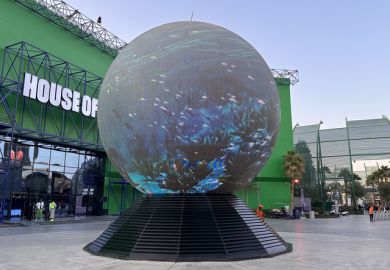We live “under the conditions of image saturation”, writes Yale University art historian David Joselit, who argues, after Bruno Latour’s actor-network theory, that images, “through the capacity for replication, remediation, and dissemination at variable velocities”, have vast power and that it is necessary to understand and harness their power “for progressive ends”.
What I particularly like about this succulent little book is Joselit’s forensic attempts to pin down terms, to make things clear, to say what he is trying to do. This includes a specially commissioned set of diagrams, deployed with variable success, with which he tries to capture the complex spatial and temporal nature of his words.
Central to this is the value or the currency of art (hence, by implication, some forms of architecture, which is my field). Joselit defines three types of art. One is “neoliberal”: investments sold in prestigious auction houses, infinitely reproducible and migrant - “contemporary global artwork” gaining value through translation. The second, which he calls “fundamentalist”, includes native objects that derive value from being “rooted to a specific place”. The final type is the “documented object” that is accompanied by so much information that it can move without drastic loss of value. This leads to a discussion of art’s “diplomatic portfolio”. Art can be used as leverage in games of power - in which museums play a major part.
Joselit notes a shift in contemporary art towards a “manipulation of populations of images”, a key exemplar being Sherrie Levine’s Postcard Collage #4. These draw attention away from what is being presented and towards “their framing networks” - the individual experience of looking at each one, the awareness of more and so on. He makes a call for a revised critical methodology reflecting a shift from “an object-based aesthetics in both architecture and art to a network aesthetics premised on the emergence of form from populations of images”.
Art’s interface with architecture comes where the latter has tried to generate form from fields of information - “a population, or currency, of images”, as in parametric designs in which the architectural surface, for example Foreign Office Architects’ Yokohama International Port Terminal, can adjust in response to changing conditions via information on site, or a design brief morphed into form through algorithms. Ironically, such buildings rarely constitute data in pure built form, and often exemplify Joselit’s particular bete noire, “object based aesthetics”, owing to the large dose of design input (and fashion consciousness) administered to them by skilful architects who still have a strong influence on the final outcome. I feel troubled by the translation of Joselit’s theories from art into architecture: if our buildings are to evolve out of information, the quality of that information will need to be gathered more rigorously and critically than it is at present. However, I also feel a sense of inevitability.
In this context, architecture begins to take on the characteristics of a “format” - “dynamic mechanisms for aggregating content”, the World Wide Web being one. Joselit contends that “what matters most is not the production of new content, but its retrieval in intelligible patterns through acts of reframing, capturing, reiterating and documenting”. This - “the Epistemology of Search” - is the networked capability of art. Its power is in its ability to make “complex and multivalent” links, a currency, Joselit argues, that must be used for “purposes other than financial profit”. What a lovely idea.
After Art
By David Joselit. Princeton University Press. 136pp, £13.95. ISBN 9780691150444. Published 13 November 2012
Register to continue
Why register?
- Registration is free and only takes a moment
- Once registered, you can read 3 articles a month
- Sign up for our newsletter
Subscribe
Or subscribe for unlimited access to:
- Unlimited access to news, views, insights & reviews
- Digital editions
- Digital access to THE’s university and college rankings analysis
Already registered or a current subscriber?



